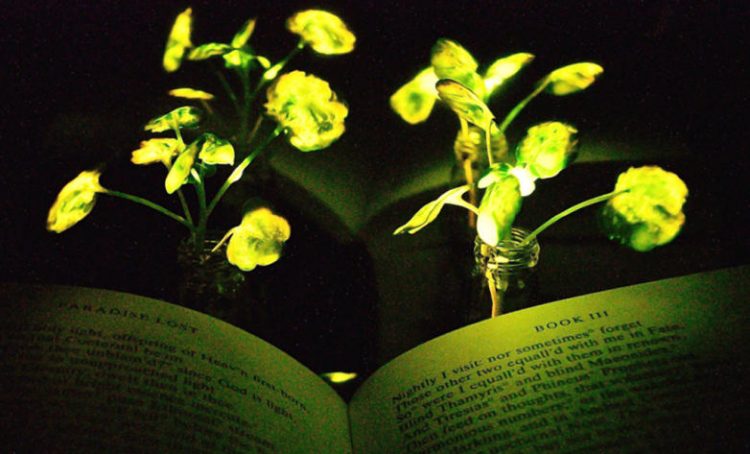MIT researchers have made an important breakthrough in their quest to make plants that glow in the dark a reality. In what they call Plant Nanobionics, the engineers embedded nanoparticles into the leaves of a watercress plant that caused the plants to give off a dim glow for three and a half hours.
Their next goal is to create plants bright enough to illuminate a workspace, but, if successful, the technology could also be used to transform trees into self-powered streetlights, the scientists claim. The team’s ultimate goal is to engineer plants to replace many of the functions currently performed by electrical devices and appliances.
“The vision is to make a plant that will function as a desk lamp — a lamp that you don’t have to plug in. The light is ultimately powered by the energy metabolism of the plant itself,” said Michael Strano, the Carbon P. Dubbs Professor of Chemical Engineering at MIT and the senior author of a recently released study on plant nanobionics.

Photo: Seon-Yeong Kwak/MIT
The researcher’s previous endeavors include designing plants that can detect explosives and report that information to a smart device, as well as plants that can monitor drought conditions. They decided that lighting, which accounts for around 20 percent of worldwide energy consumption, was a sensible subsequent objective as bioluminescent plants would significantly cut back on CO2 emissions.
“Plants can self-repair, they have their own energy, and they are already adapted to the outdoor environment,” Strano told MIT News. “We think this is an idea whose time has come. It’s a perfect problem for plant nanobionics.”
The main component of the MIT team’s luminous plants is luciferase, the class of oxidative enzymes that gives fireflies their signature glow. Luciferase converts a molecule called luciferin to oxyluciferin, causing it to emit light. A molecule called coenzyme A supports the process by removing a byproduct that can hinder luciferase activity. The MIT team packaged these components into a separate nanoparticle carrier, made from materials that the U.S. Food and Drug Administration classifies as “generally regarded as safe.” These carriers help each component arrive in the right part of the plant, as well as prevent them from reaching concentrations that could harm the plants.
Early efforts resulted in plants that could glow for up to 45 minutes, but subsequent tweaks increased the glow time to 3.5 hours. The light generated by one 10-centimeter watercress seedling is currently about one-thousandth of the amount needed to read, but the researchers believe that they can boost the light output and duration significantly by optimizing the concentration and release rates of the enzymes. They hope to eventually expand this technology to include a way to paint or spray the nanoparticles onto plant leaves, enabling them to convert trees into light sources.
“Our target is to perform one treatment when the plant is a seedling or a mature plant, and have it last for the lifetime of the plant,” Strano said. “Our work very seriously opens up the doorway to streetlamps that are nothing but treated trees, and to indirect lighting around homes.”
Interestingly, the researchers can turn off the light in the plants as well, by adding a luciferase inhibitor, enabling them to ultimately produce plants that shut off their lights in response to environmental conditions like sunlight.






